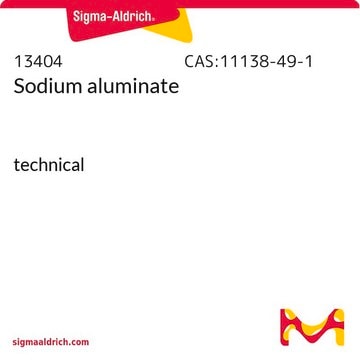229407
Aluminum isopropoxide
≥99.99% trace metals basis
Synonyme(s) :
AIP, Aluminum isopropylate, Aluminum triisopropoxide
About This Item
Produits recommandés
Niveau de qualité
Pureté
≥99.99% trace metals basis
Forme
powder and chunks
solid
Pertinence de la réaction
core: aluminum
reagent type: catalyst
Pf
128-133 °C (lit.)
Densité
1.035 g/mL at 25 °C (lit.)
Chaîne SMILES
CC(C)O[Al](OC(C)C)OC(C)C
InChI
1S/3C3H7O.Al/c3*1-3(2)4;/h3*3H,1-2H3;/q3*-1;+3
Clé InChI
SMZOGRDCAXLAAR-UHFFFAOYSA-N
Vous recherchez des produits similaires ? Visite Guide de comparaison des produits
Catégories apparentées
Description générale
Application
- Sol-gel precursor to synthesize ZnAl2O4 powders for transparent ceramics.
- Precursor material for the fabrication of nanosized SAPO-34 zeolites with a 4-fold increase in catalytic lifetime and significantly increased selectivity.
- A starting material to prepare long-persistent luminescence materials for display devices and bioimaging.
- Coating material to fabricate electrodes for lithium-ion batteries to enhance cycling stability and performance.
- A catalyst for alkylation of resorcinol with camphene.
Mention d'avertissement
Danger
Mentions de danger
Conseils de prudence
Classification des risques
Flam. Sol. 1
Code de la classe de stockage
4.1B - Flammable solid hazardous materials
Classe de danger pour l'eau (WGK)
WGK 1
Point d'éclair (°F)
60.8 °F - closed cup
Point d'éclair (°C)
16 °C - closed cup
Équipement de protection individuelle
Eyeshields, Gloves, type P3 (EN 143) respirator cartridges
Certificats d'analyse (COA)
Recherchez un Certificats d'analyse (COA) en saisissant le numéro de lot du produit. Les numéros de lot figurent sur l'étiquette du produit après les mots "Lot" ou "Batch".
Déjà en possession de ce produit ?
Retrouvez la documentation relative aux produits que vous avez récemment achetés dans la Bibliothèque de documents.
Les clients ont également consulté
Articles
The diversity of applications and nanostructured materials accessible using ultrasonic spray methods are highlighted in this article.
Three approaches generate white light, including LED-based down-conversion for broader applications.
Lanthanide ions in spectral conversion enhance solar cell efficiency via photon conversion.
Ultrasonic spray pyrolysis produces scalable nanomaterials like metal oxides and quantum dots for diverse applications.
Notre équipe de scientifiques dispose d'une expérience dans tous les secteurs de la recherche, notamment en sciences de la vie, science des matériaux, synthèse chimique, chromatographie, analyse et dans de nombreux autres domaines..
Contacter notre Service technique










